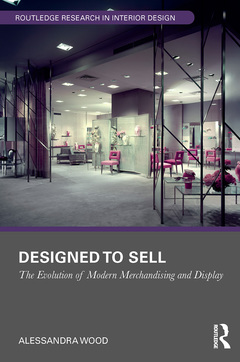Description
Designed to Sell
The Evolution of Modern Merchandising and Display
Routledge Research in Interior Design Series
Author: Wood Alessandra
Language: English
Subjects for Designed to Sell:
Keywords
Houston Public Library; Grand Leader; Interior Display; Merchandise Display; Retail Design; Raymond Loewy; Store Interiors; Women’s Wear Daily; Visual Merchandising; Suburban Store; Scientific Selling; Hagley Museum; Penney Stores; Higher Cost Departments; Suburban Branch; Baker Library; Good Life; Show Windows; Show Window; Retail Interiors; Corporate Visual Identity System; Branch Store; Regional Shopping Center; Bala Cynwyd; Interior Merchandising
Approximative price 46.39 €
In Print (Delivery period: 14 days).
Add to cartPublication date: 01-2023
· 15.6x23.4 cm · Paperback
Publication date: 03-2020
· 15.6x23.4 cm · Hardback
Description
/li>Contents
/li>Readership
/li>Biography
/li>
Designed to Sell presents an engaging account of mid-twentieth-century department store design and display in America from the 1930s to the 1960s. It traces the development of postwar philosophies of retail design that embodied aesthetics and function and new modes of merchandise display, resulting in the emergence of a new type of industrial designer.
The evolution of aesthetics in department stores during this period reflected larger cultural shifts in consumer behaviour and lifestyle. Designed to Sell explores these changes using five key case studies and original archival sources to reveal the link between designers and consumption beyond the design of individual objects. It argues that design is not simply connected to retail consumption, but that it is capable of controlling how and where customers shop and what they are drawn to purchase.
This book contextualises this discussion and brings it up to date for students and scholars interested in design, retail, and interior history.
Introduction
Scope and Thesis
Vocabulary
Chapter Organization
Note on Sources
1 Setting the Stage: Design and Display at the Turn of the Twentieth Century
Merchandising at the Turn of the Century
Spectacle and the Museumification of Displays
Display Men, Window Dressers, and the First Merchandisers
Display Before Visual Merchandising: "Scientific Selling"
2 The Development of Visual Merchandising
Professionalization of Interior Display
The Introduction of "Visual Merchandising"
3 Downtown Remodeling: Implementing New Conversations
Selling Modernism
Raymond Loewy and The Foley Brothers Department Store
Gimbels Gets The Raymond Loewy "Magic Touch"
4 The Challenge of Efficiency in a Specialty Shop
Differences in Display: Merchandising in Upscale Specialty Stores
Neiman Marcus, 1941 and 1953
5 Seeing Change: The "Personality" of a Store
Early Suburban Branch Locations
"Informality" at Neiman Marcus, Preston Center
Raymond Loewy Associates’ "Community" Building
6 "Image Building" In the Shopping Center, the 1960s
From Small-Town Store to National Retailer: The J.C. Penney Company
Together Under One Roof: The NorthPark Mall
Conclusion
Alessandra Wood is a design historian with an eye towards the future. She received her PhD in History of American Civilization at the University of Delaware, her MA in History of Design and Decorative Arts from Parsons, The New School for Design, and her BA in History of Art from Johns Hopkins University. A lover of design history and theory, she is obsessed with applying that knowledge to understand what makes products beautiful, useful, and successful, and what inspires people to love those products. With expertise in scaling design processes, she has a refined eye for style, and strives to make art and design accessible to all. Her current role as Vice President of Style at Modsy has allowed her work on the compelling challenge of reimagining the way we design our homes. In her free time, Alessandra is an adjunct professor of design history and theory.



